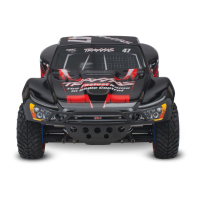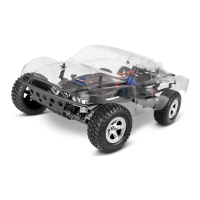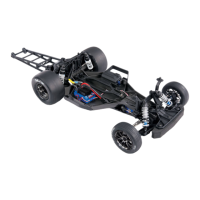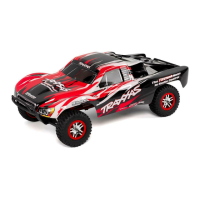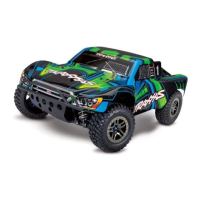
Do you have a question about the Traxxas Slash 4x4 Ultimate 68077 and is the answer not in the manual?
| Brand | Traxxas |
|---|---|
| Model | Slash 4x4 Ultimate 68077 |
| Category | Remote controlled car |
| Language | English |
Carefully read all instructions to prevent damage and ensure safe operation.
Identifies warnings, helpful hints, and cross-references using icons throughout the manual.
Provides contact information for support and registration procedures.
Outlines the essential procedures to get your model up and running quickly.
Highlights key features like aluminum components, GTR shocks, and specialized tires.
Details FCC and Industry Canada compliance information for the device.
Stresses safe operation, age limits, and points to remember for user safety.
Provides specific safety precautions for operating the electronic speed control.
Warns about fire hazards and critical safety measures for LiPo batteries.
Provides essential warnings and precautions for handling and charging LiPo batteries.
Outlines the terms of use and buyer's assumption of risk associated with the product.
Identifies core chassis, suspension, and mounting parts for the model.
Details the motor, electronic speed control, and battery placement.
Locates the receiver, servo, and antenna for the radio control system.
Identifies the drive shaft and slipper clutch assembly.
Lists the tools provided with the model for initial setup and maintenance.
Lists essential equipment like batteries and chargers needed for operation.
Suggests optional tools and safety gear for better maintenance and operation.
Emphasizes reading safety precautions and charging the battery pack before use.
Guides on installing transmitter batteries and the model's battery pack.
Explains powering on the radio, checking servos, and range testing.
Suggests applying decals and provides initial driving tips.
Highlights critical maintenance steps for optimal performance.
Introduces the radio/power system and defines key technical terms.
Explains the 2.4GHz spread spectrum and frequency band used.
Covers BEC, brushless motors, ESC, and battery types like LiPo and NiCad.
Details motor kV rating and the cogging phenomenon.
Guides on applying decals for personalization.
Defines battery types (NiMH) and motor/electrical terms (Resistance, Rotor).
Explains receiver, servo, transmitter, trim, and 2-channel system functions.
Details ESC features like thermal shutdown and its general function.
Lists crucial safety precautions for the radio system's antenna and operation.
Identifies the controls and components of the transmitter and receiver.
Shows wiring connections between transmitter, receiver, ESC, and motor.
Advises on the correct type of batteries for the transmitter.
Provides step-by-step instructions for installing transmitter batteries.
Details how to charge the included NiMH battery pack.
Discusses using other battery types and their performance implications.
Explains the procedure for charging LiPo battery packs safely.
Guides on installing the battery pack into the model.
Describes configuring the compartment for different battery types.
Provides specifications for the model's battery compartment.
Covers transmitter controls, fail-safe, and operational rules for the radio system.
Details basic adjustments like throttle neutral, steering trim, and multi-function knob.
Explains how to use the TQi radio system for operation.
Details the procedure for range-testing the radio system.
Provides instructions for binding the transmitter and receiver.
Explains how to adjust steering sensitivity using the multi-function knob.
Guides on properly setting up the receiver antenna for optimal range.
Covers Low-Voltage Detection settings for battery protection.
Guides on ESC programming, calibration, and operation.
Explains how to select and use different ESC driving profiles.
Interprets ESC LED indicators and explains protection modes.
Lists important driving precautions and tips to extend model run time.
Discusses factors affecting the model's run time and power output.
Details how to operate the model in wet conditions safely.
Lists checks before and maintenance after running in wet or muddy environments.
Provides specific precautions for the motor in wet conditions.
Explains how to maintain the watertight seal of the receiver box.
Guides on removing and installing the receiver from its box.
Explains how to set the gear mesh for optimal performance and durability.
Details how to adjust the camber angle of the wheels for better handling.
Explains how to adjust toe-in for stability and handling.
Guides on adjusting shock mounting positions for different terrain.
Explains how to center the steering servo before installing the horn.
Details how to adjust the slipper clutch for tire spin control.
Covers routine inspections, chassis, suspension, steering, and driveline maintenance.
Provides instructions for storing the model properly.
Guides on removing front and rear suspension and slipper clutch assemblies.
Covers gear ratio recommendations and camber gain adjustments.
Explains how to adjust roll center and correct bump steer.
Covers gearing, LiPo battery usage, and temperature monitoring/cooling.
Lists the technical specifications for the Velineon 3500 motor.
Explains how to tune differentials by changing oil and provides removal steps.
Guides on refilling differentials and explains the center differential.
Explains how to tune shocks by changing oil and pistons.
Covers replacing shock oil, disassembling, and reassembling shocks.
Explains how to adjust sway bars for improved handling.
Covers the Traxxas Link app, wireless module, and pairing process.
Details various tuning adjustments available on the transmitter.
Explains the fail-safe function and how to restore factory defaults.
Covers knob settings, model memory management, locking, and deleting models.
Provides a visual guide to navigating the transmitter's menu tree.
Illustrates an example of navigating the menu tree to adjust settings.
Offers a formulaic approach to transmitter adjustments without the menu tree.
Records settings for suspension geometry, shocks, wheels, and tires.
Records settings for motor, ESC, gears, differentials, and sway bars.
Notes track conditions, body type, weight distribution, and battery placement.

